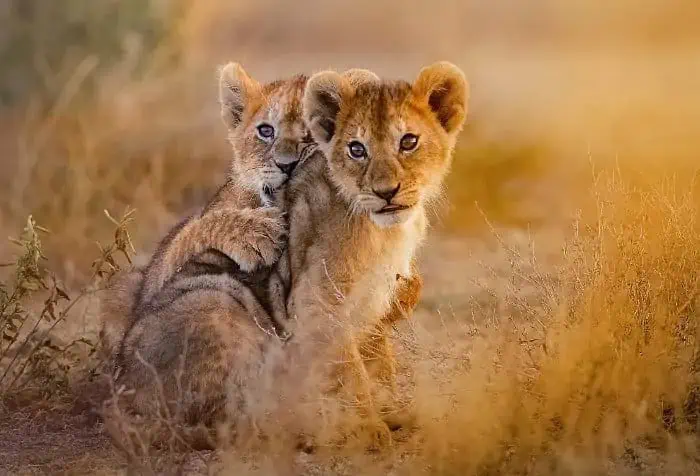The Early Life of a Lion Cub
A lion cub, or “Simba” as they are affectionately known in Kiswahili, begins life at a disadvantage. Born blind and utterly dependent on their mother, these cubs are vulnerable to a variety of dangers, including trampling by large herbivores or attacks from other predators. The first few weeks of their lives are critical, as their survival hinges on the mother lion’s vigilance and care.


Lionesses have a gestation period of about 110 days and can give birth to up to six cubs per litter, although two to three is the average. To protect her newborns, a mother lion hides her cubs in secluded spots, moving them regularly to avoid detection by predators. The cubs’ camouflaged fur—a mix of black and tawny spots—helps them blend into the grass and brush.

Becoming Part of the Pride
At around two months old, lion cubs are introduced to the rest of the pride. This social group, typically composed of related females, their offspring, and a small number of males, plays a crucial role in the cubs’ upbringing. Pride members share responsibilities for the cubs’ protection and education, teaching them the skills they’ll need to survive in the wild.

Despite the pride’s protection, life for lion cubs is fraught with dangers. From the threat of other predators to human-induced challenges such as poaching, the path to adulthood is perilous. It’s a testament to the resilience of these young lions and the effectiveness of their family structure that any survive to adulthood.
Learning to Survive
As they grow, cubs begin to learn the intricacies of hunting, with lionesses serving as their primary teachers. By three months, they start to show proficiency in the skills they will need to become successful predators. This training is vital for their survival and eventual integration into the pride’s hunting routines.

The Journey to Independence
Lion cubs typically remain with their birth pride until they are about two to three years old. Female cubs may stay with the pride for life, gradually taking on more significant roles in hunting and pride defense. Males, however, must strike out on their own, often forming bachelor groups until they are strong enough to challenge for control of a pride.


Conservation Efforts
Despite their iconic status and formidable prowess, African lions face significant threats from habitat loss, hunting, and human encroachment. Conservation efforts focus on protecting lion habitats and promoting coexistence between lions and local communities. Educating tourists and locals alike about the importance of not engaging in harmful interactions with cubs is vital for their future survival.


Conclusion

Baby lions represent the future of their species, a beacon of hope for conservationists striving to protect these majestic animals. By understanding more about their early lives and the challenges they face, we can better appreciate the importance of conservation efforts. Supporting responsible wildlife tourism and spreading awareness are crucial steps toward ensuring that the savanna remains ruled by its rightful kings and queens.
Watch the video below to witness the captivating world of baby lions and learn more about how we can help secure their future.
[Watch the video]






